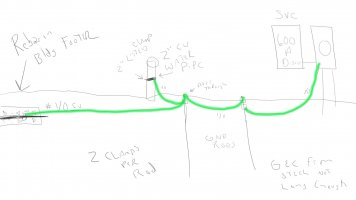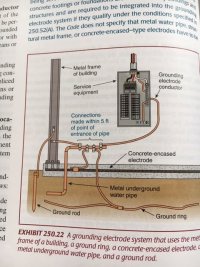jar546
Forum Coordinator
Here is the scenario:
* Service located during footer pour, a 1/0 cu wire properly tied to rebar in footer before the pour.
* Service location changed by owner/GC after footer pour complete.
* 1/0 wire not long enough to get to new location of the main service disco outside.
The plan is to do what is drawn in attached photo. I drew this with a mouse in Photoshop so sorry for the crappy job.
The existing 1/0 from the rebar inside the footer will be taken to a ground rod where it will pass through without splicing to another ground rod where it will be terminated on a clamp. Each ground rod will have 2 listed/labeled clamps. Where the GEC from the footer goes through the ground rod, the second clamp will then be use to connect 1/0 to the exterior 2" cu water pipe. The 2nd rod which will be closer to the main disco will use one clamp to terminate the end of the GEC coming from the concrete encased electrode and the other clamp to attach new 1/0 that will then continue on to the service disco where it will terminate at the neutral bar lug.
This is not the method I want to use, I don't believe this would be a code compliant installation since the GEC needs to be continuous and building steel is available.
For those that ask why we are using ground rods at all, I can't answer that other than they are show on the prints, otherwise not required due to the CEE.
My plan was to:
1) Irreversible crimp to join the existing 1/0 and a piece that is long enough to get to the service disco.
2) Add another irreversible crimp to add a pice of 1/0 to run over to the 2" water pipe.
3) Install the stupid, unnecessary ground rods to match the prints and have the GEC as a pass-through.
4) Terminate in the service disco as required
Is the method described first compliant in your opinion? NEC 2014 applies.
Yes, I know you will read this in the morning (you know who you are) and will talk to me about it at work.

* Service located during footer pour, a 1/0 cu wire properly tied to rebar in footer before the pour.
* Service location changed by owner/GC after footer pour complete.
* 1/0 wire not long enough to get to new location of the main service disco outside.
The plan is to do what is drawn in attached photo. I drew this with a mouse in Photoshop so sorry for the crappy job.
The existing 1/0 from the rebar inside the footer will be taken to a ground rod where it will pass through without splicing to another ground rod where it will be terminated on a clamp. Each ground rod will have 2 listed/labeled clamps. Where the GEC from the footer goes through the ground rod, the second clamp will then be use to connect 1/0 to the exterior 2" cu water pipe. The 2nd rod which will be closer to the main disco will use one clamp to terminate the end of the GEC coming from the concrete encased electrode and the other clamp to attach new 1/0 that will then continue on to the service disco where it will terminate at the neutral bar lug.
This is not the method I want to use, I don't believe this would be a code compliant installation since the GEC needs to be continuous and building steel is available.
For those that ask why we are using ground rods at all, I can't answer that other than they are show on the prints, otherwise not required due to the CEE.
My plan was to:
1) Irreversible crimp to join the existing 1/0 and a piece that is long enough to get to the service disco.
2) Add another irreversible crimp to add a pice of 1/0 to run over to the 2" water pipe.
3) Install the stupid, unnecessary ground rods to match the prints and have the GEC as a pass-through.
4) Terminate in the service disco as required
Is the method described first compliant in your opinion? NEC 2014 applies.
Yes, I know you will read this in the morning (you know who you are) and will talk to me about it at work.


